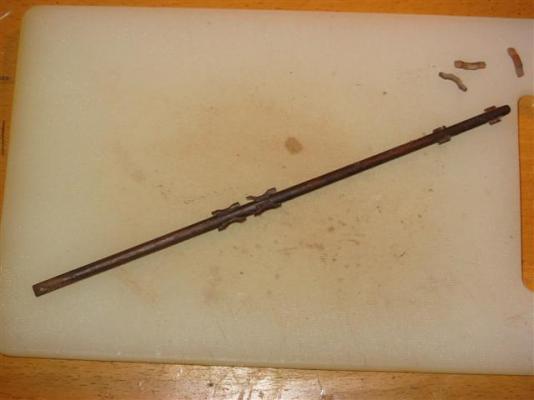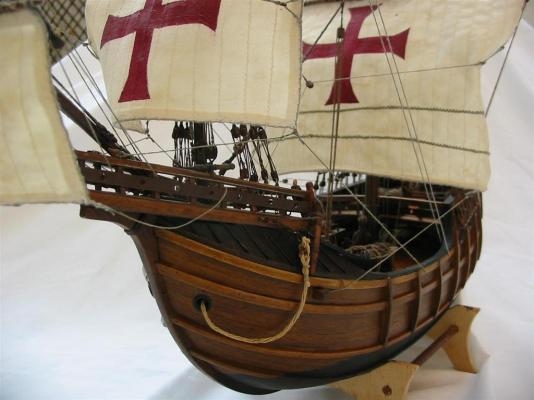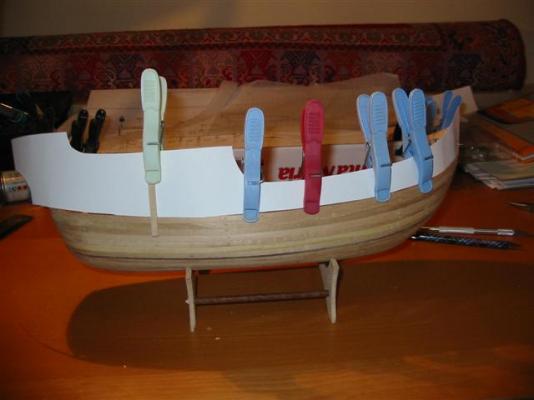-
Posts
193 -
Joined
-
Last visited
Content Type
Profiles
Forums
Gallery
Events
Everything posted by marktime
-
- 124 replies
-
- santa maria
- mantua
-
(and 1 more)
Tagged with:
-
I think you'll have to do better with your sketch before we can give you an full answer: The bowlines (red) are taken forward to sheaves secured by a tackle on forward end of the bowsprit. The bowlines return to be secured to cleats mounted either side at the base of the bowsprit. I'm not clear as to what you represent with green and yellow lines.
- 124 replies
-
- santa maria
- mantua
-
(and 1 more)
Tagged with:
-
Good job there jastrząb. The parrels look authentic Following your build with interest..
- 124 replies
-
- santa maria
- mantua
-
(and 1 more)
Tagged with:
-
Is one per mast sufficient? Nice authentic looking sheave block, a double will look even better I'm sure:
- 274 replies
-
- Santa Maria
- Artesania Latina
-
(and 2 more)
Tagged with:
-
The standing rigging is a mix of the Fernandez-Duro and Guillén replicas with an eye to creating a satisfying line.The additional rigging that is taken down to the windless is a hoist having seen this feature on other vessels and appreciating the need for a hoist to launch the boats and for loading into the main hatch.
- 274 replies
-
- Santa Maria
- Artesania Latina
-
(and 2 more)
Tagged with:
-
Jean-Pierre, pleasure to see you here. Could the foremast be raked forward to facilitate dropping the foresail yard seeing that the foresail could only be furled with the yard brought down to the deck? Bug, a quick look at Xavier Pastor p. 89 has brought me up to speed on the halliard. Ii is what I have called "falls".
- 274 replies
-
- Santa Maria
- Artesania Latina
-
(and 2 more)
Tagged with:
-
Whoa! there my friend- Look at p.112 of your Vanguard. You'll see references to belaying pins, cleats and kevels. The Knight head was a a sturdy fixed block taken down to the keel and a tackle comprised of several parallel sheaves mounted within a single block that was used to raise and lower the main yard. Smith points out that foot ropes were not in use so that the yard was lowered to furl the mainsail. Now to lift a rigged yard took a lot of effort so the main yard hoist comprised two ropes (falls) hauled by two teams at the same time: when the yard was level the order "marry the falls" brought the two ropes together and the crew hauled the yard as one team. Been there, done it with ships boats. Mechanical advantage gained with ropes and pulleys implies the larger the gain, the longer the rope. So there would have been a lot of rope around the knight head when the yard was hoisted and tied into place and I surmise that the likely place that would serve as storage was either lashed to the knight head itself or the rigging above it. Not sure what you are referring to with the "Halliard"
- 274 replies
-
- Santa Maria
- Artesania Latina
-
(and 2 more)
Tagged with:
-
Absolutely agree with you on the pumps. Well, that's because of this....... "Fifteenth and sixteenth century ship's pumps consisted of three main components: a pump shaft, a piston rod and valves......early suction pumps worked on the simple mechanical principle of drawing water up through a tube...... with a one way valve. The pump shaft was fashioned from a a straight tree trunk ...or fashioning a tube of individual planks, like the staves of a barrel.....The base of the pump shaft in the bottom of the bilge was fitted with a foot valve made up of short baulk of bored wood fitted with a leather flapper valve on top........Water usually exited the pump tube through a hole in its side near the top above deck level. On the fourth voyage, Columbus was forced to stand for Jamaica, "especially since the ships were so eaten by shipworms, that day and night we never stopped pumping water with the three pumps. If one broke down, kettles were substituted for the job while it was being fixed. Despite these efforts, the caravels could not be kept afloat and at God's mercy, we beached in Jamaica." Extracts from "Vanguard of Empire - Ships of Exploration in the Age of Columbus" Roger C. Smith. Oxford University Press. A fantastic resource for information on the architecture and building of ships of this period. Bug, your detail looks very authentic, makes me want to go back and redo mine!
- 274 replies
-
- Santa Maria
- Artesania Latina
-
(and 2 more)
Tagged with:
-
Liked the bombards (which you are calling cannon, tut! tut!). And thanks for the acknowledgement. There are three other Santa Maria builds on this forum and you are doing a great job in inspiring them to go that extra mile.
- 274 replies
-
- Santa Maria
- Artesania Latina
-
(and 2 more)
Tagged with:
-
The twist probably comes from your method of threading the dead-eyes. Try another threading sequence so that when you pull on the top dead eye the threads stay flat. Otherwise, nice build.
- 29 replies
-
- santa maria
- amati
-
(and 1 more)
Tagged with:
-
That is an excellent introductory log and many would do well to learn how to present their work in such an interesting fashion. Good job on the railings. Add my pleasure to see you here again with the others.
- 274 replies
-
- Santa Maria
- Artesania Latina
-
(and 2 more)
Tagged with:
-
Spray them with a starch and then use a blow-drier to shape them.
-
Muy bonita, como siempre. From your good friend in Tenerife.
- 71 replies
-
- santissima trinidad
- finished
-
(and 1 more)
Tagged with:
-
62 are the spritsail sheets, ropes that allow the the spritsail to be trimmed, i.e. to keep the sail filled with wind.. One end will be fixed to a cleat mounted on the inboard face of the foc's'cle bulwark and the other belayed on the belaying pin No. 62. These sheets are normally left slack on the model as there is no counter force to keep them taut. Edit: My interpretation of the Santa Maria based on the Martinez-Hidalgo replica has only a single sheet for each foot of the spritsail so in that case, you have a single rope to belay on pin 62.
- 124 replies
-
- santa maria
- mantua
-
(and 1 more)
Tagged with:
-
Kimberley. Just to reassure you that your placing of the bowsprit was correct: its foot passes the the foot of the foremast below deck and as the foremast is on the centreline the bowsprit is angled so it to comes up through the foc's'le off-centre. Tucks, the architectural name given to the stern configuration. Most of the wooden model kits for pre-XVI th century vessels are supplied as square tucked because it's easier to model, so the stern is flat. Your model has a nice round bottom.
- 94 replies
-
- santa maria
- revell
-
(and 1 more)
Tagged with:
-
Aah! Good to see a round tuck on the Santa Maria. Square tuck arrived in the XVIth century.
- 94 replies
-
- santa maria
- revell
-
(and 1 more)
Tagged with:
-
We are having even more fun watching your build. I'm learning a lot about plastic models just by following your progress. 'Aint this forum wonderful?
- 94 replies
-
- santa maria
- revell
-
(and 1 more)
Tagged with:
-
Yes I noted the electrics. Will look stunning when it's finished.
- 79 replies
-
- santa maria
- amati
-
(and 2 more)
Tagged with:
-
I think you are being too modest! Great hatch cover hinges. Are you going to add a way to lift the hatch cover?
- 79 replies
-
- santa maria
- amati
-
(and 2 more)
Tagged with:
-
You are demonstrating a very high standard for a novice modeller so I imagine you are a craftsman in some other trade. An outstanding build and a well photographed progression of your work.
- 79 replies
-
- santa maria
- amati
-
(and 2 more)
Tagged with:
-
Changing the colour of the dead-eyes rigging is a great improvement.
- 124 replies
-
- santa maria
- mantua
-
(and 1 more)
Tagged with:
About us
Modelshipworld - Advancing Ship Modeling through Research
SSL Secured
Your security is important for us so this Website is SSL-Secured
NRG Mailing Address
Nautical Research Guild
237 South Lincoln Street
Westmont IL, 60559-1917
Model Ship World ® and the MSW logo are Registered Trademarks, and belong to the Nautical Research Guild (United States Patent and Trademark Office: No. 6,929,264 & No. 6,929,274, registered Dec. 20, 2022)
Helpful Links
About the NRG
If you enjoy building ship models that are historically accurate as well as beautiful, then The Nautical Research Guild (NRG) is just right for you.
The Guild is a non-profit educational organization whose mission is to “Advance Ship Modeling Through Research”. We provide support to our members in their efforts to raise the quality of their model ships.
The Nautical Research Guild has published our world-renowned quarterly magazine, The Nautical Research Journal, since 1955. The pages of the Journal are full of articles by accomplished ship modelers who show you how they create those exquisite details on their models, and by maritime historians who show you the correct details to build. The Journal is available in both print and digital editions. Go to the NRG web site (www.thenrg.org) to download a complimentary digital copy of the Journal. The NRG also publishes plan sets, books and compilations of back issues of the Journal and the former Ships in Scale and Model Ship Builder magazines.







